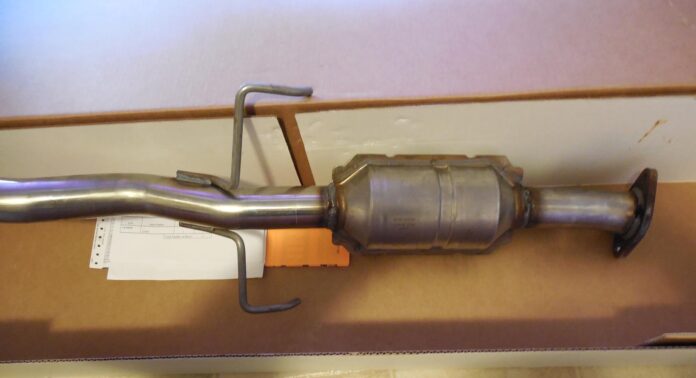Catalytic Converter
The liver is an essential part of the human body. Your liver’s primary job is to detoxify and metabolize chemicals and drugs coming from your digestive tract before they enter the bloodstream. Although livers are designed to last a lifetime, they may fail if clogged with fat.
A catalytic converter does the same thing for your car. A catalytic converter is a crucial part of your vehicle’s emissions system. Catalytic converters are designed to last a lifetime but can fail if they become clogged. The exhaust gases from your vehicle can’t pass through the muffler if this happens, as it often happens with old cars. As a result, the gases cannot get out of the vehicle’s rear and can’t escape its front, eventually causing the engine to fail due to an insufficient mixture of fuel and air. The catalytic converter does not work correctly. This guide will learn about clogged catalytic converter symptoms and their working.
How does the catalytic converter work?
A catalytic converter reduces emissions from the engine’s exhaust by using chemical reactions. The assembly will be split into two sections if you divide it in half. There are usually two converters on a vehicle – one near the engine (the light-off cat that handles NOx). A downstream O2 sensor determines how efficient this converter is. The cat that handles HC and CO is located in the car’s rear (it is usually a separate unit from the front with newer cars) and does not have a downstream O2 monitoring unit. One of them is a catalyst composed of platinum and rhodium. Nitrogen oxide (NOx) is broken down into nitrogen and oxygen molecules by this process.
A second catalyst, consisting of platinum and palladium, is added to the exhaust gas stream as it travels further. The two-way oxidation of carbon monoxide (CO) and hydrocarbons (HC) breaks them down into molecules of less harm, such as carbon dioxide (CO2) and water (H2O). If the fuel mix is balanced, it will produce mostly water and CO2. A slightly rich mixture will cause CO as there is not enough oxygen (not enough O2), while a leaking injector or a vibrant mixture will cause high HC levels (hydrocarbons – unburned fuel) to appear as soot in the exhaust.
Nitrogen, which makes up 78 percent of the atmosphere in a combustion chamber, is superheated during combustion, which drives the piston downward due to the NOx produced. The combustion chamber temperature must exceed two thousand five hundred degrees to produce NOx. It is known as NOx (x can be one of several numbers) when nitrogen molecules bond with oxygen molecules above 2500 degrees.
The oxygen (O2) molecule from the first catalytic conversion bonds with the carbon dioxide to form CO2. Hydrogen and carbon molecules split to form CO2 and H2O from the hydrocarbon compound.
Clogged catalytic converter symptoms
A catalytic converter is a critical component in your vehicle’s exhaust system. It is responsible for converting the harmful pollutants in your exhaust gas into less harmful substances before being released into the atmosphere. However, over time, the catalytic converter can become clogged, which can lead to some serious issues. Here are some common symptoms of a clogged catalytic converter:
Decreased Performance: A clogged catalytic converter can cause a reduction in engine performance, causing your vehicle to feel sluggish, and have difficulty accelerating.
Reduced Fuel Efficiency: A clogged catalytic converter can also result in reduced fuel efficiency, as your engine may have to work harder to move your vehicle, resulting in increased fuel consumption.
Unusual Engine Sounds: A clogged catalytic converter can create a rattling or vibrating sound in your engine.
Foul Odor: A clogged catalytic converter can cause a noticeable sulfuric smell to come from your exhaust.
Check Engine Light: If your vehicle’s check engine light comes on, it can indicate a problem with your catalytic converter.
If you experience any of these symptoms, it’s recommended to get your vehicle checked by a mechanic as soon as possible to prevent further damage to your car’s engine.
What is the best way to check for a bad catalytic converter? Here are five clogged catalytic converter symptoms:
1. A problem is preventing your car from starting
A symptom of liver failure is sleepiness or difficulty getting out of bed in the morning. Clogged catalytic converters can have the same effect on your car, making it very difficult to start the engine. Clogged catalytic converters prevent exhaust gases from leaving the car, which causes the engine to stall from increased exhaust pressure. At first, your vehicle might seem normal, but then it could stall or sputter due to a problem with your catalytic converter.
2. Your fuel efficiency isn’t good
Have you noticed that your gas mileage has decreased? Has it happened suddenly? This could be another sign of a failing catalytic converter. The less oxygen your engine receives, the harder it must work. The more complex your engine works, the more fuel it consumes. The more fuel it consumes, the fewer miles per gallon you’ll be able to get from it. As fatigue and a low appetite are common symptoms of a clogged liver, they are similar.
3. It’s time to check your engine light
You will know when your liver is failing when your body shows signs of it, and your car’s warning light will alert you when it is malfunctioning. Most modern cars and chances are pretty good that yours comes with an onboard diagnostic system that automatically tests the catalytic converter. The air to fuel ratio sensors triggers the check engine light if your tailpipe emits too much pollution.
An affected catalytic converter may be caused by a faulty component in another part of the car, such as a spark plug. If you think there’s a problem, you should also schedule an inspection, so replace lousy spark plugs.
4. Emissions testing of your vehicle failed
Catalytic converters are an integral part of your vehicle’s emission system, so it makes sense that a failed emissions test indicates a defective catalytic converter. If your liver enzymes are out of whack on a blood test administered by a doctor, then it makes sense that your liver might be failing.
You must have your vehicle’s emissions tested every year in Ohio. Tests will let you know if a catalytic converter is functioning correctly since it is the main component responsible for vehicle emissions. If you fail the test, you may have increased levels of carbon emissions, contaminated antifreeze, or contaminated motor oil, or any of the other symptoms listed above.
5. Poor acceleration is your experience
Also, if your vehicle doesn’t accelerate properly when your foot is on the gas pedal, your catalytic converter could be clogged. Reduced engine performance and efficiency are also red flags because they usually indicate that exhaust is plugged up in the catalytic converter.
You may have no fuel reaching your engine if your vehicle jerks or completely stalls when you try to accelerate. Catalytic converters can clog as a cause of this problem. You can potentially repair a clogged catalytic converter if you address it before it damages other components of your car, just like you can treat liver failure if you catch it early enough.
FAQs (Frequently Asked Questions)
Read More: A Definitive Guide About Where Is The Carburetor On A Lawnmower?
- What is the sound of a clogged catalytic converter?
There is a rattling sound coming from under the vehicle when driving or idling due to a bad catalytic converter. Generally, this is more apparent when starting the vehicle. The converter’s heat or damage breaks the honeycomb materials, resulting in a rattling sound.
- If your catalytic converter is clogged, what will happen?
Cars that jerk forward lose fuel during acceleration or stall out. You will have trouble managing pressure when your catalytic converter is clogged. If your catalytic converter is essentially “choked” with a buildup of particles, your engine will have difficulty breathing.
- Is the catalytic converter replaceable?
Catalytic converters can be repaired without requiring replacement, as long as they don’t rattle, discolor, warp, or smell sulfurous.
Apart from this, if you are interested to know more about How To Install An Electric Water Heater then visit our Home Improvement category.









